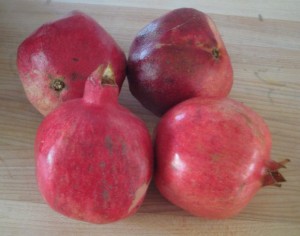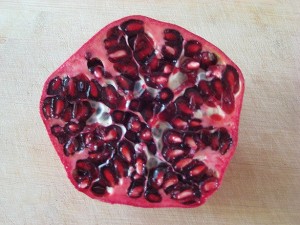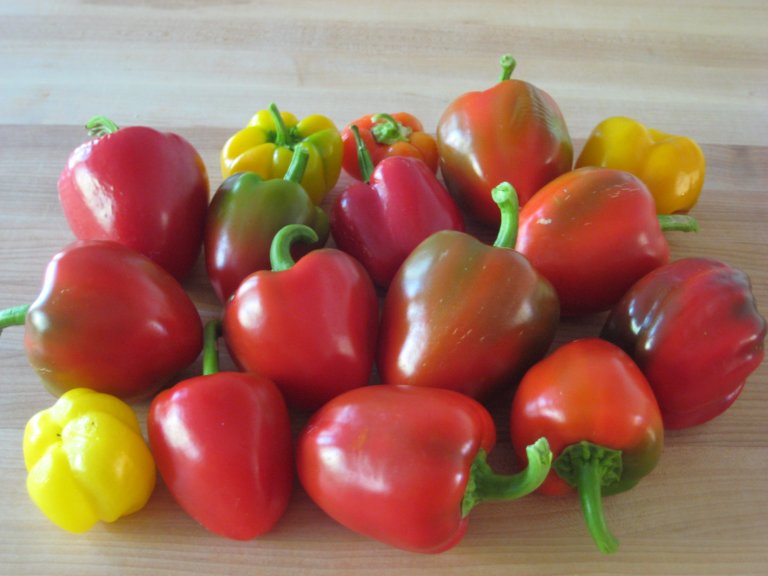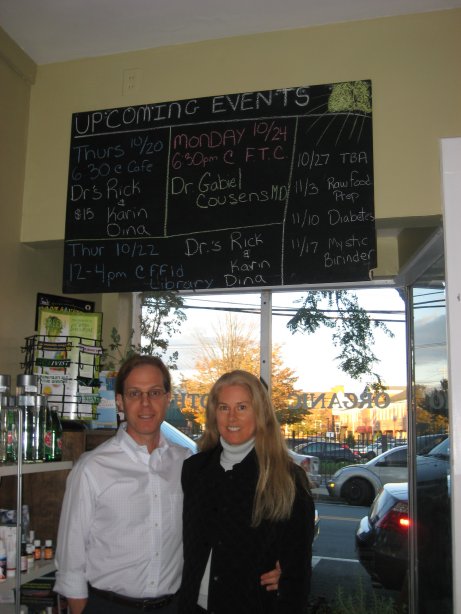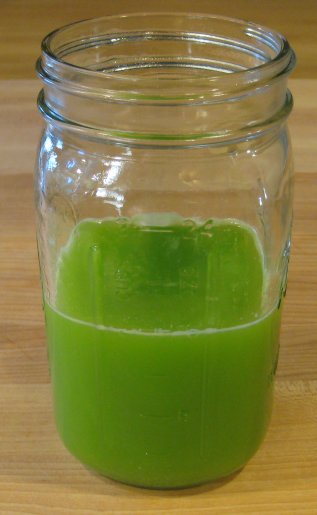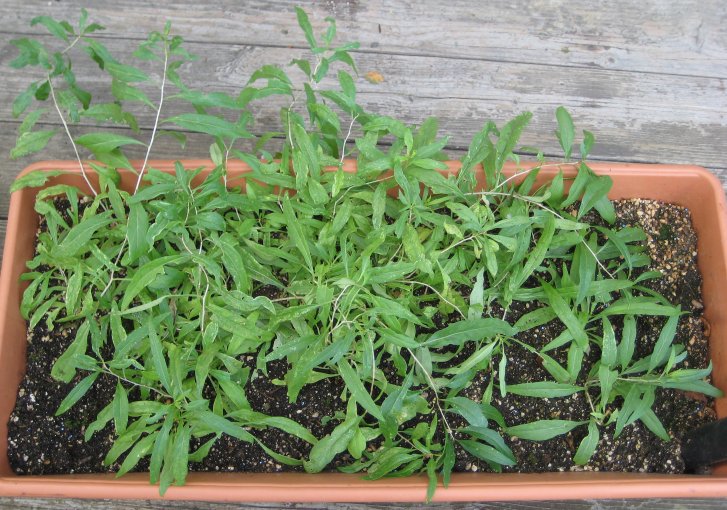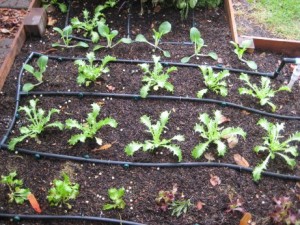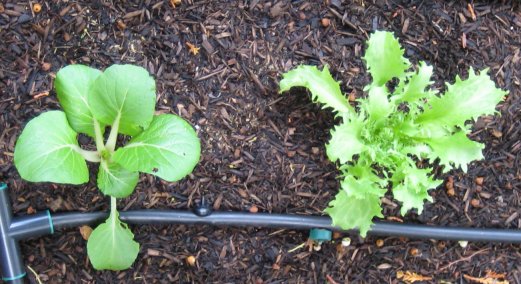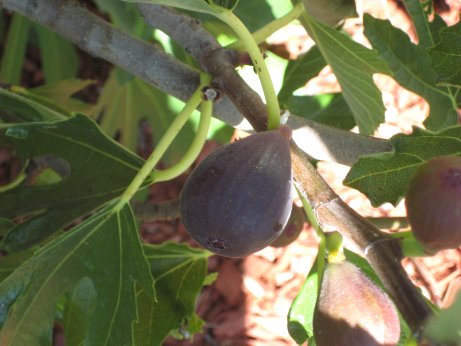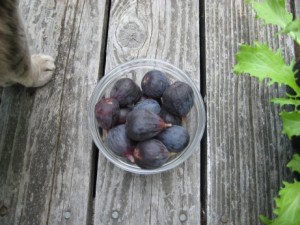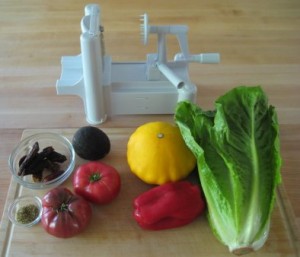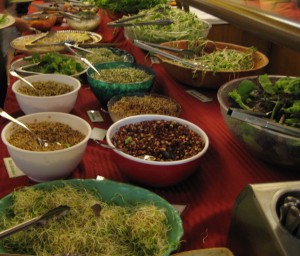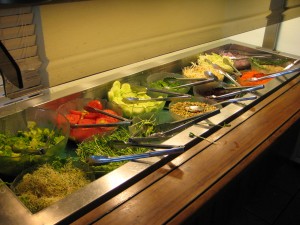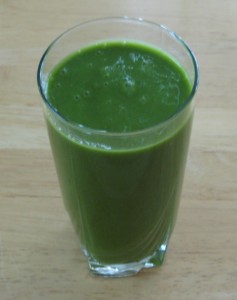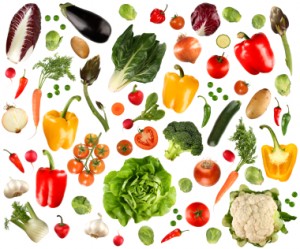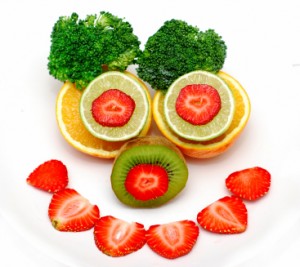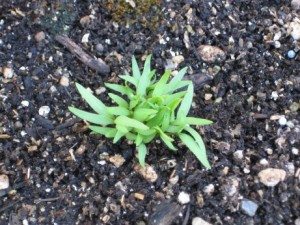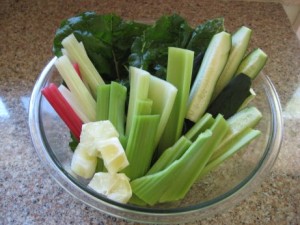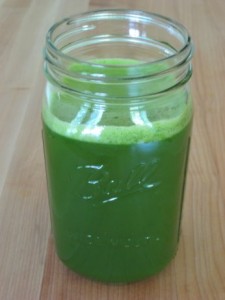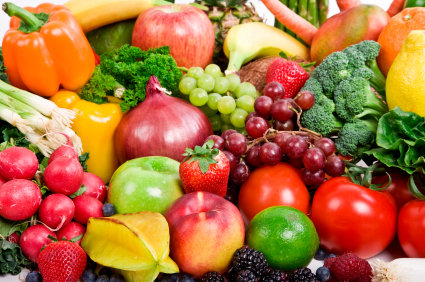‘Tis the season to be festive, so Rick and I thought we would share one of our favorite holiday recipes with you! We have always loved pumpkin pie, so this recipe is a raw, whole food sweetened version of the filling for the traditional favorite.

A very popular question that we are asked is “what type of sweetener do you use?” We very rarely use sweeteners in our recipes, but when we do use a sweetener, it is dates. There many possible alternative sweeteners which each may be more appropriate for specific recipes, but we prefer to use dates because they are a whole food and we enjoy the taste. We also consider simplicity and nutrient content when developing our recipes.

Here is the recipe, which makes 24 ounces or four 6-ounce servings:
- 2 Cups peeled fresh butternut squash
- 6 Medjool dates or ¾ cup of other type of dates
- ⅓ Cup soaked raw almonds (best if soaked for at least 8 hours prior to making recipe)
- ½ Cup good quality water (more may be necessary)
- 1 Tsp. ground cinnamon
- ½ Tsp. chopped fresh ginger
- ¼ Tsp. ground nutmeg
This recipe can also be used as filling for a raw pie, or one can substitute 2 cups of chopped pumpkin for the butternut squash if desired. Just remember to use pie pumpkin, which we have found to be more flavorful than the Jack-o-lantern type. 🙂
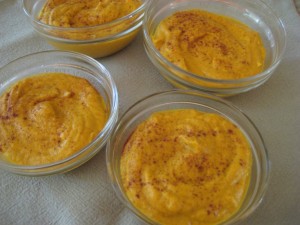
Here is how we prepare this recipe:
- Add ½ cup water to high powered blender, followed by spices and dates
- Blend until ingredients are reasonably homogenous
- Add ½ cup of butternut squash to mixture and blend, then add ½ cup of squash and blend, continue this process until all squash is blended with the mixture
- We often add some extra water during this process, if the mixture is too thick
- Add soaked almonds to the mixture and blend until mixture is completely smooth
- Pour into dessert glasses and sprinkle a pinch of ground cinnamon on top
- Chill and enjoy!
Have a Happy Thanks Living!
One of the best ways to keep in touch with us is to join our email list. You’ll receive a free copy of Our Top 12 Strategies for Long Term Success on A Raw Plant-Based Diet eBook along with regular information about raw food and plant-based diets and periodic promotions for our classes, events, and other offerings!
Great News about Raw Food Nutrition with Karen Ranzi in NJ
Many thanks to Karen Ranzi, author of the book Creating Healthy Children, for hosting us at her home in October for our 4-hour raw food class "Great News about Raw Food Nutrition".
In the class, we reviewed several scientific studies of long term raw food populations. We also covered several thorough and enlightening nutrient analyses from different popular raw food approaches, and a discussed the potential pros and cons of each. It was really revealing to break things down and see what nutrients are found on each of the raw food plans.
As always, we enjoyed connecting with raw food enthusiasts, sharing information, and answering questions. If you or your group would like to host us for an event in your area, please get in touch with us through the "contact us" page on this website.
One of the best ways to keep in touch with us is to join our email list. You’ll receive a free copy of Our Top 12 Strategies for Long Term Success on A Raw Plant-Based Diet eBook along with regular information about raw food and plant-based diets and periodic promotions for our classes, events, and other offerings!
What I learned from pomegranates
A tongue-in-cheek antidote to all of the complicated research that I read:
Pomegranates were, at one time, a fruit that I did not understand. Being from the northeast, I had never seen anyone eat one, but this did not deter my curiosity about them.
Back in the pre-internet era, the first time I attempted to eat a pomegranate, I tried to peel off the tough outer skin only to find more tough fiber on the inside interspersed with pockets of numerous seeds each surrounded by a small, delicate, dark red fluid-filled pouch that promptly burst as I tried to remove them. They are called arils.
My wood cutting board was stained a lovely shade of magenta for days after this attempt.
When I moved to northern California, I would regularly see pomegranates at the local farmer’s market and in produce departments of natural food stores during the months of November and December. I would hear from friends and students about how delicious pomegranates taste, but it was only recently when I was researching the antioxidant content of pomegranates, that I decided to revisit this fascinating fruit.
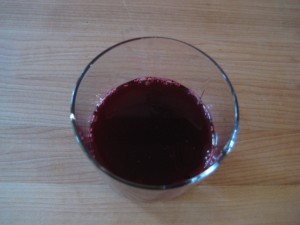
Not surprisingly, many people I know who consume pomegranates do so in the form of juice. Which raises the question: how does one juice pomegranates? I tried several juicing methods that were available in my kitchen and found that the use of a handheld citrus juicer was easiest and cleanest for me.
Here is what I did:
I cut a couple of pomegranates into quarters, placed the pomegranate quarters into the citrus squeezer one at a time, and squeezed the citrus squeezer into a large glass bowl. Out came the juice with relatively little effort and mess! So simple! And the juice was delicious - similar to cranberry juice but a lot sweeter. Both Rick and I loved it.
So, here is what I learned from this experience:
- Pomegranates do not peel like an orange. 🙂
- Using a nice bamboo or wood cutting board will very likely end in stains. Hmmmm….
- My answer to pomegranate preparation was simple. This makes me wonder what other issues that can seem complicated at first may have simple answers once one educates oneself. 🙂
What simple answers are you overlooking in your life?
Has anyone juiced pomegranates with a citrus press?
One of the best ways to keep in touch with us is to join our email list. You’ll receive a free copy of Our Top 12 Strategies for Long Term Success on A Raw Plant-Based Diet eBook along with regular information about raw food and plant-based diets and periodic promotions for our classes, events, and other offerings!
Early November Red Bell Peppers
This is the first year that we attempted to grow bell peppers in our garden. A friend, who is a gardener extraordinaire, came over this spring to help us build a small raised bed for our first pepper crop. Throughout the summer we watched the plants grow, flower, and then bear small fruits. The small fruits grew slowly and gradually started to change color from green to red, with some shade of brown in between. As you can see from the photo below, some turned yellow! As November neared, we wondered if the numerous peppers would fully ripen before the weather became too cold.
Last week, almost overnight, a large percentage of the peppers turned almost completely red. We were excited, so we picked a couple and enjoyed them in our salad dressing that night. We sampled the peppers and found that they were some of the most flavorful red bells that we had ever tasted. There is no doubt that home grown vegetables tend to be incredibly flavorful, especially in comparison to their store-bought counterparts. These bell peppers were certainly no exception, but rather, exceptional.
Red bell peppers are well known for their vitamin C and beta-carotene content.
Here are some of the nutrition highlights of red bell peppers:
| One cup chopped red bell pepper | |
| Calories | 46.2 |
| Vitamin C | 190.3 mg |
| Beta-carotene | 2419.8 mcg |
I also looked up the nutrient content of green bell peppers for comparison:
| One cup chopped green bell pepper | |
| Calories | 29.8 |
| Vitamin C | 119.8 mg |
| Beta-carotene | 309.9 mcg |
Per calorie, the vitamin C content of red and green bell peppers appears to be similar, at least for the samples compared. Beta-carotene content, however, is much higher per calorie in red bell peppers than green. Ripeness appears to make a difference in this case.
One of the best ways to keep in touch with us is to join our email list. You’ll receive a free copy of Our Top 12 Strategies for Long Term Success on A Raw Plant-Based Diet eBook along with regular information about raw food and plant-based diets and periodic promotions for our classes, events, and other offerings!
Catch a Healthy Habit Cafe in Fairfield, CT
Many thanks to Glen Colello and Lisa Storch, for recently hosting us for two successful programs at Catch a Healthy Habit café in Fairfield, Connecticut. We did an evening talk with a food demo followed by a weekend 4-hour workshop, where we shared much information about science-based raw food nutrition.
 As always, it was fun to connect with so many raw food enthusiasts to share experiences and information. For those of you in the area, Catch a Healthy Habit is a vibrant raw food café in Fairfield center with lots of great menu items including smoothies, juices, salads, entrees, and creative desserts. Glen and Lisa also host a number of great health speakers there regularly. What a great raw food and plant-based health resource – in southern CT!
As always, it was fun to connect with so many raw food enthusiasts to share experiences and information. For those of you in the area, Catch a Healthy Habit is a vibrant raw food café in Fairfield center with lots of great menu items including smoothies, juices, salads, entrees, and creative desserts. Glen and Lisa also host a number of great health speakers there regularly. What a great raw food and plant-based health resource – in southern CT!
One of the best ways to keep in touch with us is to join our email list. You’ll receive a free copy of Our Top 12 Strategies for Long Term Success on A Raw Plant-Based Diet eBook along with regular information about raw food and plant-based diets and periodic promotions for our classes, events, and other offerings!
Light Green Juice
A family member recently asked me about green juice, and expressed an interest in recipes and tips for making it tasty. I LOVE green juice and have many recipes that I enjoy, which I am happy to share. There is one challenge, this family member does not like the taste of dark leafy greens: raw, steamed, juiced, in a green smoothie, etc. This is by no means unusual, since I have met many people over the years that are turned off by the taste of greens, especially when they are new to healthy eating.
I can understand that the strong taste of such greens is often an acquired taste, and may take some “getting used to”. Since this loved one is just getting started with juicing, I shared a recipe for “light” green juice with milder-tasting ingredients, such as celery, lemon, and cucumber. This is actually the base juice that I use for my green juices with more ingredients. Here is the recipe:
5 stalks of celery (12” long)
1 lemon, peeled
1 medium cucumber, 8” long
This recipe makes about 2 cups of juice. Here are some of the nutrients found in these ingredients:
| Light Green Juice ingredients | Adult Daily Values | |
| Calories | 120.7 | |
| Calcium | 198.0 | 1000 – 1200 mg |
| Iron | 1.99 | 8 – 18 mg |
| Zinc | 1.07 | 8 – 11 mg |
| Magnesium | 81.05 | 310 – 420 mg |
| Potassium | 1390.39 | 4700 mg |
I love the lemony taste, but there is much one can do with green juice – the sky is most certainly the limit. I have sampled many creative and delicious green juices over the years. This one is quick and easy to make, I spend about 20 minutes from start to finish, including set up and clean up time!
One of the best ways to keep in touch with us is to join our email list. You’ll receive a free copy of Our Top 12 Strategies for Long Term Success on A Raw Plant-Based Diet eBook along with regular information about raw food and plant-based diets and periodic promotions for our classes, events, and other offerings!
Goji Berry Plants – 4 Months Old
Our goji plants have grown quite a bit since we planted the seeds in June – it's time for transplanting 🙂
One of the best ways to keep in touch with us is to join our email list. You’ll receive a free copy of Our Top 12 Strategies for Long Term Success on A Raw Plant-Based Diet eBook along with regular information about raw food and plant-based diets and periodic promotions for our classes, events, and other offerings!
Fall Garden Greens
Here in northern California, many different types of foods can grow throughout the fall, winter, and spring, especially greens. Right now, some of our summer crops are still producing, such as heirloom tomatoes, bell peppers, and summer squash, which are doing well despite the rain and cool night temperatures we have been experiencing lately. We do have space in our garden for fall plants, so last week, I went to a local farmer’s market, and purchased some plant starts, including red and green leaf lettuce, bok choy, and frisée greens. Here is a picture of these plants now growing in our garden:
This Sunday, we returned from a weekend out of town teaching our Science of Raw Food Nutrition I class (it was fun, as always!) to find that our starts had almost doubled in size! Right now, it appears that the frisée greens have the lead over the bok choy and lettuce, but later in the season we will see which of our greens will be the ultimate champion size-wise.
Nutritionally speaking, all of these plants have their attributes. Bok choy is often praised for its mineral content, but what about much less heard-of frisée greens?
Here are some nutrient highlights of frisée greens:
| 3 cups chopped frisée greens (150 g) | Adult Daily Values | |
| Calories | 25.5 | |
| Calcium | 78 mg | 1000 – 1200 mg |
| Iron | 1.24 mg | 8 – 18 mg |
| Zinc | 1.18 mg | 8 – 11 mg |
Young bok choy and frisée greens:
One of the best ways to keep in touch with us is to join our email list. You’ll receive a free copy of Our Top 12 Strategies for Long Term Success on A Raw Plant-Based Diet eBook along with regular information about raw food and plant-based diets and periodic promotions for our classes, events, and other offerings!
Early October Figs
I love October. There are so many things to love about this beautiful month, such as the fall foliage, crispness of the air, leaf piles (dare I jump in? :)), pumpkins, the availability of certain fresh foods that are challenging to find at other times of the year, and the list goes on. One of the foods available now in northern California is fresh figs, such as those ripening on a tree in our front yard.
Before I moved to California, I thought of figs as strange looking dried fruits found in a bulk bin at my local health food store. When I first tried fresh figs, I found that the flavor and texture were quite different from the dried version. I do enjoy dried figs, and eat them from time to time, but I really enjoy fresh figs. People have asked me if I have any good fresh fig recipes – sorry, I do not. The reason why is because figs tend to disappear rather quickly in my house. 🙂
How long will these figs last in our house? Get out the stopwatch…..
The first time I saw a nutrient analysis of figs, I was amazed at the calcium and iron content, which is higher than most fruits per calorie. Potassium content is notable, too. Here are some nutrition highlights of figs:
| 6 medium figs (300 g) | Adult Daily Values | |
| Calories | 222 | |
| Calcium | 105 mg | 1000 – 1200 mg |
| Iron | 1.11 mg | 8 – 18 mg |
| Potassium | 696 mg | 4700 mg |
One of the best ways to keep in touch with us is to join our email list. You’ll receive a free copy of Our Top 12 Strategies for Long Term Success on A Raw Plant-Based Diet eBook along with regular information about raw food and plant-based diets and periodic promotions for our classes, events, and other offerings!
Raw food recipe for heirloom tomato marinara sauce and summer squash noodles
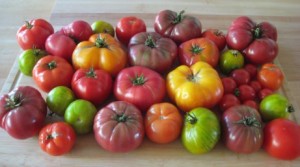 Last night, Rick and I had a couple of friends over for dinner to share in our heirloom tomato harvest. 🙂 We made spiralized squash with some sunburst squash from the garden and a marinara sauce from garden tomatoes, sundried tomatoes and some other simple ingredients:
Last night, Rick and I had a couple of friends over for dinner to share in our heirloom tomato harvest. 🙂 We made spiralized squash with some sunburst squash from the garden and a marinara sauce from garden tomatoes, sundried tomatoes and some other simple ingredients:
Marinara Sauce (one serving)
2 medium fresh tomatoes (2 cups chopped)
6 soaked sun dried tomatoes (1 ounce dry or 28.3 g)
½ tsp. dried oregano or other Italian spices
1 medjool or other type of date
¼ ripe avocado or one tablespoon of chia seeds
We blended the fresh tomatoes, spices, date, and avocado in a high powered blender, then added soaked sundried tomatoes and blended until smooth. For a lower fat recipe, one could leave out the avocado or chia seeds. For garlic lovers, one could add ¼ clove of fresh garlic. We used heirloom tomatoes from our garden for this recipe, but popular red varieties would work well too.
To make squash pasta, we used a vegetable spiralizer. The resultant “noodles” had the consistency of linguine al dente, since the squash used was mature – we let some of the summer squash in our garden get a little too big this year.
In general, for spiralizing, we like to use squash or zucchini that is younger in order to create softer noodles. We added the noodles to a bed of romaine lettuce mixed with chopped red bell pepper:
Summer squash pasta and salad (one serving)
4 cups spiralized yellow summer squash served on a bed of 4 cups of lettuce mixed with 1 cup of chopped red bell pepper.
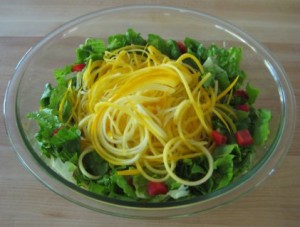 Here are some nutrients in the sauce, pasta, and salad:
Here are some nutrients in the sauce, pasta, and salad:
| Recipes | Adult Daily Values | |
| Calcium | 245 | 1000 – 1200 mg |
| Iron | 8.4 | 8 – 18 mg |
| Magnesium | 239 | 310 – 420 mg |
| Potassium | 4125 | 4700 mg |
| Zinc | 3.7 | 8 – 11 mg |
Here is a picture of the final dish:
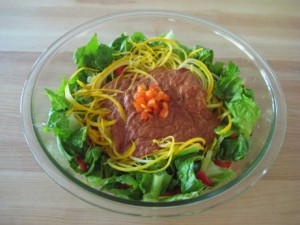
It was sooooo good 🙂
One of the best ways to keep in touch with us is to join our email list. You’ll receive a free copy of Our Top 12 Strategies for Long Term Success on A Raw Plant-Based Diet eBook along with regular information about raw food and plant-based diets and periodic promotions for our classes, events, and other offerings!
September Blackberries
Today was an especially hot day (over 90º F) in Sonoma County and aside from the leaves on the maple tree in my front yard turning red, one would hardly guess that autumn is upon us. One of the many things that I love about northern California is late summer blackberries. Even though these beautiful and tasty berries are available throughout the summer and into the fall, I love berry picking in September since a number of the berries on a given bush are ripe and practically fall into my hands as I pick them. My favorite blackberry bush is located in a park close to my house where I find myself checking on the progress of the berries from time to time during the summer months when I pass by while out on a run or walk.
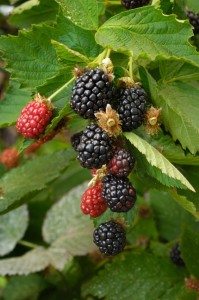
Today, I picked some to enjoy in a green smoothie. Here are some nutrient highlights of blackberries:
One cup (144 grams) of blackberries contains 62 calories, 33% of the daily value (DV) for vitamin C, 4% of the DV for calcium, 5% of the DV for iron, 7% of the DV for magnesium, 5% of the DV for potassium, 7% of the DV for zinc. One cup of blackberries also contains 184 mcg of beta carotene and 170 mcg of lutein and zeaxanthin. Blackberries have been studied for their antioxidant content, including anthocyanins which may lend a red, purple or blue color to various fruits and vegetables, such as blueberries and raspberries.
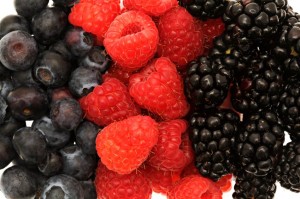
Given that one cup of blackberries contains 62 calories, which is 3% of the calories consumed on a 2,000 calorie diet, blackberries contain reasonable percentages of the important nutrients mentioned above.
Source for nutrient information on blackberries: USDA nutrient database
One of the best ways to keep in touch with us is to join our email list. You’ll receive a free copy of Our Top 12 Strategies for Long Term Success on A Raw Plant-Based Diet eBook along with regular information about raw food and plant-based diets and periodic promotions for our classes, events, and other offerings!
Life Food Gourmet in Miami
The raw restaurant Life Food Gourmet in Miami was an exceptional experience in many ways. For starters, the décor is fashionable and comfortable. The owner of the restaurant happened to be there when we were ordering, and talked to us for a few minutes about the history of Life Food Gourmet. He was very kind and interested in our experience at his restaurant – which was fabulous. I had one of the BEST salads I have ever had at a raw restaurant.
Rick and I are tough customers when it comes to large salads at raw restaurants, and we were amazed to see that this salad was so well sized. Usually, salads at raw restaurants are a little small for our taste, but this one was much larger than expected. Additionally, the combination of ingredients in the salad and the dressing was outstanding flavor-wise. 🙂 I was impressed. In the spirit of Café Gratitude, I would name this salad “I Am Impressed!” The actual name of the salad was House Salad.
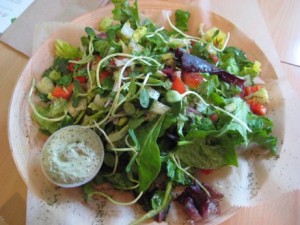
We also enjoyed our hummus plate (Mediterranean Nachos) and Burrito. Kudos to the staff and owner(s) of this exceptional restaurant – we thoroughly enjoyed our experience there. Next time we go to south Florida, Life Food Gourmet will be on our list of must-go places!
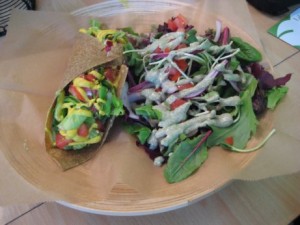
One of the best ways to keep in touch with us is to join our email list. You’ll receive a free copy of Our Top 12 Strategies for Long Term Success on A Raw Plant-Based Diet eBook along with regular information about raw food and plant-based diets and periodic promotions for our classes, events, and other offerings!
Hippocrates Health Institute Presentation
We had dinner and gave a presentation to students at Hippocrates Health Institute in West Palm Beach, one of the nights we were in south Florida. The dinner spread was beautiful:
And the food was delicious! I loved the salad and dressing, greens, and the variety of prepared raw plant dishes. Our presentation was enjoyable and many attendees stayed after the presentation and talked to us about various raw food topics. We always appreciate connecting with raw food enthusiasts! Here is Dr. Rick Dina, D.C. presenting at Hippocrates in Wigmore Hall, named after the late raw food educator Ann Wigmore:
We will be presenting in Connecticut and New Jersey in October! Please see our events page for venue details.
One of the best ways to keep in touch with us is to join our email list. You’ll receive a free copy of Our Top 12 Strategies for Long Term Success on A Raw Plant-Based Diet eBook along with regular information about raw food and plant-based diets and periodic promotions for our classes, events, and other offerings!
Ultra Wellness Conference in Florida
In late June, Rick and I spoke at the Ultra Wellness conference at the Regency Health Resort and Spa in Hallandale Beach, Florida. I know this was two months ago, but hey, better late than never! The conference was great, it is always fun presenting to and spending time with like-minded people interested in health. In addition to the conference, we also did an evening talk at Hippocrates Health Institute in West Palm Beach and visited an exceptional raw food restaurant in Miami.
I’ll cover our experience at Hippocrates and the raw restaurant in upcoming posts, so stay tuned! Today, let’s talk about the Regency and Ultra Wellness Conference. The Regency Health Resort and Spa is located right ON THE BEACH and would be an incredible winter vacation destination. Here is a view of the ocean from the back deck:
The beach setting of the Regency is one of the most attractive features of the resort, along with the pool and the fabulous food! The fare at the Regency is a combination of both cooked and raw plant based dishes. Rick and I like to eat relatively simply, so the generous salad bar at lunch was totally up our alley. Here is the lunch salad bar:
Breakfast was fresh fruit with non-fruit options and dinner was usually a delicious cooked meal with a raw option. At the conference, Rick and I presented on "New Science of Raw Food Nutrition" to enthusiastic conference attendees and spent time answering their thoughtful questions. One of my favorite aspects of teaching is the question and answer session, which gives us a chance to help our students have a better understanding of nutrition and how the body works!
Here is a picture of the Regency:
And the beautiful beach behind it:
One of the best ways to keep in touch with us is to join our email list. You’ll receive a free copy of Our Top 12 Strategies for Long Term Success on A Raw Plant-Based Diet eBook along with regular information about raw food and plant-based diets and periodic promotions for our classes, events, and other offerings!
The New USDA MyPlate – Moving Toward a Plant-Based Diet
I have to say, I was pleasantly surprised when I saw the recently updated dietary suggestions released by the U.S. Department of Agriculture in the form of a dinner plate, called MyPlate. The new icon presents the five food group concept, from the former food pyramid, in a simpler and more relatable style that encourages Americans to move toward a plant based diet.
The MyPlate guidelines encourage people to make half of their plate fruits and vegetables. The vegetable group contains a variety of veggies: chlorophyll-rich dark leafy greens, antioxidant rich red and orange vegetables, starchy vegetables, beans and peas, and other types of vegetables, many of which are popular staples of raw food enthusiasts. Beans and peas also fall under the protein category, as do nuts and seeds. The fruit group contains a wide variety of fruits generally available in natural food markets and grocery stores, making them easily accessible. Many fruits that raw food enthusiasts use in green smoothies can be found on this list.
The remaining half of the plate is divided into the grain group and the protein group. The grain group contains both whole and refined grain options, with gluten free choices. Raw food cuisine favorites such as buckwheat, quinoa, wild rice, and amaranth are on the list. Given that a large number of people in the U.S. consume the standard western diet with plenty of processed grains and refined grain products, the MyPlate suggestion to consume at least half of grains as whole grains is a step in the right direction. Keeping the recommendations relatable and “doable” for the general population is important encourage people to consider healthier options. I personally would like to see more of an emphasis on whole food choices.
Although the protein portion of the plate includes the choice of fish and lean cuts of red meat or chicken, there are numerous choices for vegetarians and vegans including beans, nuts, and seeds. Raw food favorites such as almonds, sesame seeds, pumpkin seeds, and cashews made the list. The MyPlate guidelines encourage people to vary their protein sources by choosing plant sources of protein.
Overall, MyPlate suggests consuming less fat and more fiber rich foods such as fruits, vegetables, grains, and beans. MyPlate also stresses the importance of exercise and eating an appropriate number of calories. Processed foods and foods that are high in added sweeteners and fats tend to be more calorie dense than whole foods, so the probability of consuming more calories per meal is much higher when one is consuming processed foods than when one is consuming whole foods.
The biggest difference between the former recommendations and the new MyPlate is the new icon, but there are some additional notable changes. For example, the dairy group on the former pyramid only gave options from dairy products, while the new MyPlate gives the plant-based option of calcium fortified soy milk. I personally would like to see this section expanded to include more calcium-rich plant-based options. MyPlate encourages people to read food labels to identify saturated fat, trans fat, sodium, and added sugar content. It also reminds people that sugar is often disguised on food labels under many names including: sucrose, glucose, high fructose corn syrup, corn syrup, and fructose. MyPlate makes an important suggestion: drink water instead of sugary drinks, because of their empty calorie content.
Overall, I applaud the USDA for suggesting that people consume whole foods, with an emphasis on whole natural plant foods. I am also happy to see the restyled presentation of their suggestions as the MyPlate icon. I think this is a very relatable and understandable way to convey dietary information to the American public. Of course, there are many areas where I would like to see improvements, but as a basic blueprint for people eating the standard western diet, I think that this model is a step in a positive direction. For those of us already consuming a whole food plant-based diet, this model provides some confirmation that we are consuming foods with numerous health benefits.
Reference: www.choosemyplate.gov
Posted in accordance with USDA MyPlate icon usage guidelines: The USDA does not endorse any products, services, or organizations.
The history of our Science of Raw Food Nutrition series of classes
We are happy to announce two new classes in the Science of Raw Food Nutrition series! Due to popular demand, we have recently added Science of Raw Food Nutrition III and the Advanced Educator course to our curriculum. This series previously consisted of the 2-day, 12 hour Science of Raw Food Nutrition I, 5-day, 35 hour Science of Raw Food Nutrition II, and 2-day Benefits of Raw Food Nutrition Educator Courses. With the two new additions, the entire series now spans 15 days and approximately 100 hours of valuable course content. These new courses have been offered just a few times so far since September of 2010 and have already received rave reviews.
Those of you interested in raw food nutrition may be interested in how this curriculum was developed. After attending the second annual Vibrant Living Expo in the summer of 2006, Dr. Karin Dina, D.C. (my wife) and I wondered if Living Light would be interested in having a regular raw food nutrition course to complement their culinary classes. A few months later at World Vegetarian Day in San Francisco, Living Light co-director Dan Ladermann approached us with the very same idea! We began with a test class in the fall of 2006, and the students really liked it. We met with directors Cherie and Dan, and it was decided that Dr. Karin and I would put together a two day, 12 hour course together called “Science of Raw Food Nutrition.” It covered (and still does, although it has been refined and improved many times since) the effects of heating on food, pH balance, blood sugar regulation, raw food sources of essential nutrients such as calcium, iron, protein, vitamins, minerals, and essential fatty acids, anti-aging and longevity, etc. In short, it was a hit!
After a few of these classes, we added a level II class and educator course to the curriculum. So from the summer of 2007 until the first level II and educator course offering in December of 2007, we spent just about every moment in between our chiropractic and nutrition consulting patients, and most evenings and weekends working on our new classes. It was a very intense time, but a labor of love. The prospect of teaching a longer series of classes, where we could build upon the topics discussed in the level I class, as well as have the time to cover many other important and related topics was very exciting to us. In fact, Sundays became our favorite days, because we could sit at the computer and work on our classes all day without interruption! The bottom line is the new classes turned out great and our students were very excited! I remember one student telling us at the end of that first level II class that she was all ready to sign up for level III!
As word got out and demand increased, we offered the new level II class series (now called Benefits of Raw Food Nutrition Educator Certification™ Series) twice in 2008, then three times in 2009, and 4 times in 2010. Beginning in September of 2010, we added Science of Raw Food Nutrition III and the Advanced Educator courses mentioned above (now called the Advanced Raw Food Nutrition Educator Certification™ Series), and offer this entire comprehensive series four times per year. Additionally, the 12-hour Science of Raw Food Nutrition I course is offered by itself 11 times per year, as a regular part of the Living Light curriculum. As we tell our students in terms of implementing raw food nutrition into their lives, the culinary classes are the “how” and the nutrition classes are the “why.” Together they are a highly synergistic combination!
We feel very “lucky” to be able to have the opportunity to see those figurative light bulbs go off over so many of our students heads when various pieces of the nutrition puzzle begin to come together and solidify for them. As far as that particular form of “luck” is concerned, Seneca, a roman philosopher who lived from 5 B.C. to 65 A.D. states it so very well. “Luck is what happens when preparation meets opportunity.”
As far the preparation component is concerned, in addition to our personal experience implementing raw food vegan diets for 45 years collectively, we have both earned 4 year doctoral (D.C.) degrees. It’s just amazing how many pieces of the puzzle come together when going through a formalized 4 year program with heavy emphasis on all of the science that provides the framework that nutrition works as an integral part of. We’ve spent thousands of additional hours in clinical practice and in scouring the peer reviewed scientific literature, as well as putting together power point presentations, course notes, instructor training kits. etc. We do this in a way that makes science easy and fun to understand for those without any kind of science background, but still fully accurate and appreciated by those who do. In our curriculum, all of the above come together in a synergistic manner.
2016 Update: After numerous requests, we are finally offering the updated and expanded version of our Science of Raw Food Nutrition classes online! The name of this course is Mastering Raw Food Nutrition. We invite you to learn more about the class here.
In gratitude,
Dr. Rick Dina, D.C.
One of the best ways to keep in touch with us is to join our email list.
You’ll receive a free copy of Our Top 12 Strategies for Long Term Success on A Raw Plant-Based Diet eBook along with regular information about raw food and plant-based diets and periodic promotions for our classes, events, and other offerings!
Growing goji berry plants – Update
Rick and I returned home from a long weekend out of town to find that our goji seeds had germinated! We are so excited! Here is a photo of two growing together.
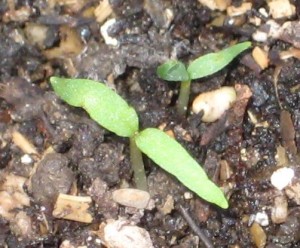
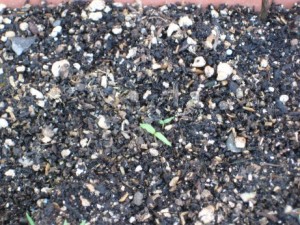
Here is a group of very young goji plants growing together. I planted a whole berry here and it appears that many of the goji seeds germinated.
Our next task is to thin the plants so each can have more space to grow. We’ll keep you updated on their progress. 🙂
One of the best ways to keep in touch with us is to join our email list. You’ll receive a free copy of Our Top 12 Strategies for Long Term Success on A Raw Plant-Based Diet eBook along with regular information about raw food and plant-based diets and periodic promotions for our classes, events, and other offerings!
A Variation on My Favorite Green Juice
Several months ago, I was at my local farmer’s market and saw some Swiss chard starts for sale from a local garden plant vendor. I have never grown chard before, so I thought it would be fun to give it a try. Well, now Rick and I have LOTS of chard growing in our garden and have the opportunity to use it in different recipes. Yesterday, I had a couple of
chard leaves in my morning smoothie and today I thought I would try it in a green juice.
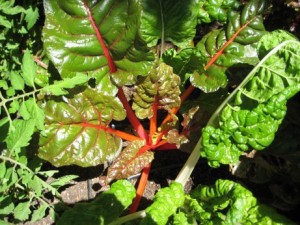
My favorite green juice recipe contains celery, cucumber, the juice of one lemon, and some type of leafy green. For the green, I like to use either kale or dandelion greens, but since I have fresh chard from the garden I used 3 leaves of it in my juice.
Here are the ingredients of the juice: four stalks of celery, one large cucumber, one peeled lemon, and 3 leaves of Swiss chard. I used our twin gear juicer to make the juice and it was really good! I really love the tart lemon taste. One can add apple or some other fruit for a sweet taste, or leave out the lemon for a “green” taste.
A nutrition note: Raw Swiss chard is NOT a rich source of calcium, due to its high oxalic acid content. I do not rely on it as a source of calcium, nor do I make juice out of it often. Swiss chard is in the goosefoot plant family, the same family as spinach and other foods that are high in oxalic acid.
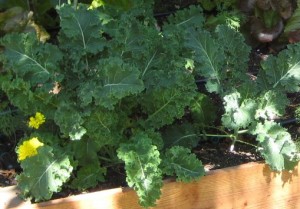
Leafy greens that are lower in oxalic acid include cabbage family plants such as kale and bok choy. There are plenty of plant food sources of calcium that we cover in our course the Science of Raw Food Nutrition Level I and will cover in future blog posts.

Some non-cabbage family leafy vegetables that I enjoy in salads include dandelion greens, endive, escarole, frisée greens (curly endive), and lettuce, of course. We’ll leave my salad contents for a future post. 🙂
Growing goji berry plants
At the time, I had never before seen an actual goji plant growing in a garden, given that goji berries are native to Asia and are not popularly cultivated as a garden crop here in the United States. Not surprisingly, the berries on the plant reminded me of tiny Roma tomatoes, given that goji berries (lycium barbarum) are in the nightshade plant family (Solanaceae), the same plant family as tomatoes, potatoes, bell peppers, eggplant, and Incan berries (a.k.a. golden berries).
I was excited to find after doing a little research that goji plants can grow in the area where Rick and I live. I am a big fan of locally grown food, so I thought it would be fun to grow some goji berry plants in my backyard garden.
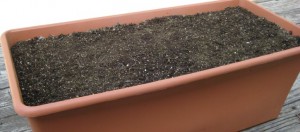
Today, I looked for a suitable container in which to grow my goji seeds. I found an unused planter, filled it with soil, and made ½ inch deep holes about 2 inches apart. I opened several goji berries to find 20+ tiny seeds in each, which I carefully removed and did my best to place one seed in each of the holes. In several of the holes, I placed a single goji berry to see if multiple seeds would germinate together. I filled in the holes with soil and then watered the planted seeds and soil.
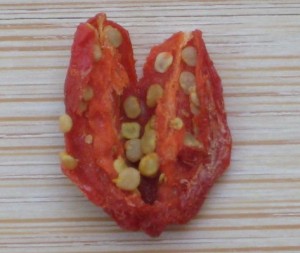
Now that the seeds are planted, I am looking forward to seeing how many, if any, actually germinate and produce plants. I’ll give you updates as the growing season progresses. 🙂
We are happy to announce….
our first blog post! We are looking forward to writing about various topics that inspire us and have helped us achieve our personal health goals.
As expected, we will be writing about fresh whole natural plant foods from a scientific/ research perspective in a relatable and fun manner. Our goal is to regularly cover topics that you find to be valuable, so our question to you is: what health and nutrition subjects would you like to read on our blog? Please let us know by writing your suggestions in the comment section below.
Yours in health,
Drs. Karin and Rick Dina, D.C.
One of the best ways to keep in touch with us is to join our email list. We send out monthly newsletters, notifications of our speaking engagements, and more:

